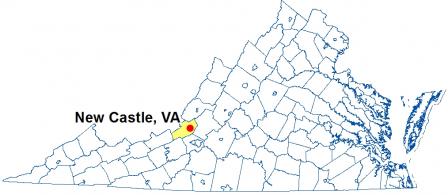Balls Score Big in Reducing Pollution
U.S. EPA Region 3 Water Protection Division
New Castle, Virginia • January 14, 2016
Though it made a big splash in Los Angeles in 2015, the use of buoyant plastic balls to control pollution is nothing new to a southwestern Virginia wastewater treatment plant.
The Craig-New Castle Public Service Authority (PSA) near Roanoke used the EPA Clean Water State Revolving Fund to purchase more than 200,000 hollow balls to provide a floating cover for a large part of a treatment lagoon. The four-inch black spheres block sunlight that contributes to algae growth.
The balls are scoring big in reducing pollution. The Craig-New Castle PSA had repeatedly violated its permit limits for Total Suspended Solids (TSS) due to excess algae and duckweed. Since the light-shielding balls were installed in June 2012, TSS levels in the plant’s discharge have plunged from a peak monthly average of 50 milligrams per liter down to around 10 mg/l – well within required levels, according to the project’s design engineer Gary Crouch of Anderson & Associates.
In drought-marred Los Angeles in August 2015, as the mayor yelled “balls away,” national media reported on the blanketing of the city’s reservoir with the last of 96 million black “shade balls” to reduce evaporation and prevent algae growth. In New Castle, Va., there was little fanfare when the balls were released. A team dragged tractor-sized bags of the balls to the edge of the banks, untied the bags “and started kicking them in,” said Donald W. Jones, the authority’s administrator and chief operator.
The 28,000-square-foot floating cover of balls was one of several projects completed by the Craig-New Castle PSA with $455,500 in CWSRF financing provided by EPA through the Virginia Department of Environmental Quality. Other projects included the addition of igloo-shaped “Bio-Domes” to speed up the wastewater treatment process, and the replacement of pumps and a section of sewer line to help reduce sanitary sewer overflows.
But the balls – with an estimated life span of up to 20 years – were the most unique aspect of the overall plant fixes. Made of UV-stabilized black high-density polyethylene, they cost 28 cents each – less than the 36-cent Los Angeles balls. The option was cheaper than a sand filtration alternative to “polish” the discharge – even with a sand plant located in town. And operation and maintenance costs aren’t a concern. “There’s no power required for the balls,” said Jones. “We just kick them back in every now and then.”

-
Balls Score Big in Reducing Pollution (PDF)(1 pg, 639 K,
01/14/2016)
Though it made a big splash in Los Angeles in 2015, the use of buoyant plastic balls to control pollution is nothing new to a southwestern Virginia wastewater treatment plant.
